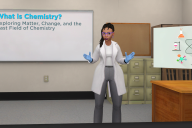You have /5 articles left.
Sign up for a free account or log in.
Paul Freedman is widely viewed as one of the more inventive and thoughtful people on the education-technology scene.
Some rank-and-file college faculty and staff members may see that as damning him with faint praise, all the more so if they remember him as the founder of Altius Education, which helped create an alternative two-year college that was effectively shut down in 2013 by the Midwestern regional accreditor.
Freedman and Altius were for a time held up as the poster children of how the traditional higher education ecosystem discourages innovation, which led some to characterize him as a charter member of the "higher education is broken and must be disrupted" club.
But Freedman defies such easy categorization, as does the entity he now leads, the Entangled Group. As the son of a University of California, Berkeley, physicist and National Academy of Sciences member, he grew up in the belly of traditional higher education and speaks more eloquently than most San Francisco-based ed-tech people about its virtues.
And while Entangled incubates and invests in companies, Freedman's shop -- which derives its name from his late father's success (with a scientific colleague) in disproving Einstein's quantum entanglement theory -- focuses on ventures that work with colleges, rather than compete with them. (It also helps colleges navigate the changing landscape with consulting services.)
Q: What does Entangled Solutions do?
A: Entangled Group is an education impact studio. Our mission is to catalyze the development of products and services that allow our education system to better support learner needs as our society shifts from a production economy to a knowledge economy. We do this by:
- Working with educational institutions, foundations, nonprofits and companies, through our innovation design agency Entangled Solutions. We use a proprietary methodology, called “future state design,” to help these organizations as they plan for their futures in these dynamic times.
- Using insights and relationships from our consulting work in order to create impactful companies or nonprofit organizations, and support a small group of externally created companies
To date, we have incubated a number of education start-ups, including Practice, ReUp Education and Pathstream, and we have launched nonprofits based in higher education quality assurance, and Matterfund. We also support externally created high-impact companies including The Guild, Raise.Me and Gradescope, among others.
Q: The company's focus -- like Ivy Bridge's -- seems to be more about amplifying what traditional colleges offer than trying to compete with them directly. Why? Are more companies and investors following your lead?
A: The term "disruptive innovation" has been so misused that the concept has essentially lost all meaning. However, the original theory described two forms of innovation: "disruptive innovation" -- in which technology-driven innovation replaces existing institutions and incumbent business models -- and "sustaining innovation," where technology enhances the position of existing institutions and businesses.
Entangled is open to supporting either type of innovation, depending on which is the right model for the problem being solved. That said, higher education institutions are very resilient and multifaceted, so there are many more opportunities for technology-driven innovation to enhance existing colleges and universities rather than displace their core functions.
In addition, I grew up on colleges campuses, and I love the collaborative and insight-driven culture of academia. I would rather see colleges and universities improve and extend their services, rather than be ignored and replaced by new providers, which is a personal bias that probably impacts our focus.
I’m not sure whether there will an emphasis on "enabling" business from the broader ed-tech community. On one hand, some of the most successful education start-ups (for example 2U, Instructure and Guild Education) have been "enablers" rather than "replacers." Investors tend to follow patterns, which could lead to more start-ups that focus on amplifying traditional offerings. On the other hand, there is a bias in venture capital against working within existing systems because doing so slows progress and requires a deep understanding of the existing nuances to be successful.
Q: We've seen a growing role for intermediaries who help to connect colleges and employers -- like Guild's work with Walmart. Why is this happening? What boundaries are Entangled and others trying to bridge?
A: Forming these kinds of relationships can be difficult, time-consuming and costly -- and maintaining partnerships like these is not the core business of either universities or employers. Therefore, it makes sense that intermediaries can create efficiencies by managing a number of similar partnerships across a network of companies and universities.
You mentioned the Guild, which is a company we advise. They have been very successful at helping establish and manage partnerships between colleges and large employers who offer education as a benefit. In addition, we have just launched a company called Pathstream that is working to enable partnerships between colleges and technology platforms (like Facebook and Unity) to teach students job-critical software skills. I’m sure we will see more companies like these.
Q: Has your notion of where higher education is ripe for disruption shifted in recent years?
A: This might surprise you, but over the years I have actually begun to think it is more likely that certain core areas of higher education will be disrupted in the classic sense.
I used to think that the combination of institutional resilience, the brand equity of many universities and the protection afforded to incumbent universities by political instruments (accrediting agencies, state [and] federal organizations) largely protected universities from core disruption. Indeed, those factors have offered, and continue to offer, protection to existing university business models. However, since the system is so weighted in their favor, universities lack appropriate motivation to adapt. This makes it likely that change will come in [the] form [of] large-scale distribution, rather than incremental reform.
More so, some universities aren’t necessarily aware of who their competitors are, which is a sure path for replacement. For example, there was a lot of discussion about MissionU at colleges and universities when it first launched, which was followed by a lot of celebration from the same folks when the company stopped offering its business-focused college-alternative program.
However, there is little recognition of venture accelerators, such as YCombinator and 500 Startups, who have been disrupting entrepreneur-focused business programs for years. In fact, YCombinator is winning the competitive battle! If you want to be an entrepreneur and are accepted into their program out of college, it is almost certainly a better path to success than going to almost any M.B.A. program in the country.
Q: How big could the nondegree, adult student postsecondary market get, and are there common traits you see in traditional colleges that are best suited to serve these students?
A: If you define nondegree as non-associate, bachelor's and master's degree, then the market will be huge and will at some point rival the "traditional" degree market. The reason for this is clear: as the Lumina Foundation and Bill & Melinda Gates Foundation have famously promoted, a knowledge economy requires around two-thirds of the population to be educated past high school. However, only around 40 percent of our population currently has an associate or bachelor's degree. The traditional degree portion of the market is not growing rapidly (and may shrink in the future), so the entirety of the growth in educational attainment will come from nondegree (at least nontraditional-degree) programs.
It terms of commonality, innovation tends to start in areas of nonconsumption, so the initial nondegree programs are in areas where there is no effective degree alternative, and are focused on learner populations who are poorly served by existing institutions.
Q: What are some of the most common misconceptions you see among college leaders about what employers want in partnerships, and vice versa?
A: The most common perspective we hear among employers is that colleges are "teaching the wrong things," and the most common perspective among colleges is that employers don’t know what talents and capabilities they should be looking for.
Our perspective is that both sides are right and wrong at the same time.
Employers are not great at articulating the competencies they need or assessing the talent that comes through the door. Historically they have relied on colleges for both, but that is changing.
Colleges and universities, on the other hand, have not adjusted their curriculum based on our society’s shift from a production economy to a knowledge economy, and are woefully inadequate at teaching learners to articulate the capabilities and know-how they have when they leave college.
Q: How do you respond to the argument by many traditional academics that the growing job-training focus in higher education is overblown and can be damaging to the liberal arts and general education?
A: There is truth to that argument. Colleges are not short-term job-training programs -- that’s not their purpose or mission, nor is it what our society needs from them.
However, the primary motivation of the vast majority of today’s college students is to get a job after college. Schools leverage career outcomes while marketing to potential students in order to enroll them. It is morally irresponsible to market and enroll students who want to get a job with their college degree and then not provide those students with the tools or resources to get the job they desire.
The fact that colleges shouldn’t be turned into career training centers, but at the same time need to be better at training people for a career, is one of the most important tensions that our higher education system will have to wrestle with in the coming decades.








